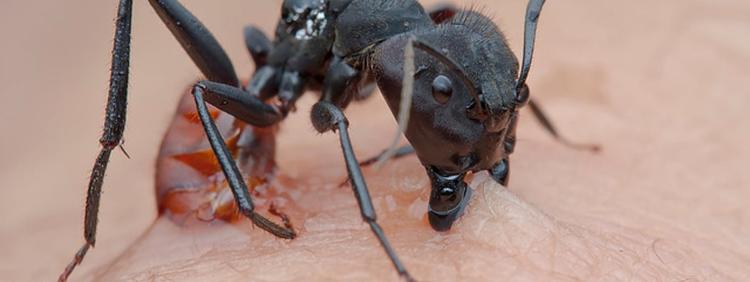Kitchener Pest Control: Everything You Need to Know About Carpenter Ant Bites

As a Kitchener homeowner, keeping your property free of dangerous pests that bite or sting is likely a priority for you, especially if you have small children or pets. Carpenter ants are among the most difficult to manage, especially once they take hold in your yard and find ways to get inside. At Truly Nolen, we are standing by to offer you carpenter ant pest control and important information about the bites these ants may cause so you can better protect your family until our technicians arrive.
1. You Can Identify Carpenter Ants Easily
The first step in treating a carpenter ant bite is to identify the species. This is not difficult, since carpenter ants are larger than fire or pavement ants and are usually black or dark brown in colour. They usually venture into human homes looking for food or water and are generally less aggressive than many fire ant species.
Some carpenter ants have wings that allow some of the young to spread to new areas. You may see these winged ants in the spring as the young search for new and viable nesting sites, but they are usually non-aggressive and may find their way into your home through an open window or crevice.
2. Carpenter Ants Have Powerful Jaws
When carpenter ant nests are disturbed or you accidentally come into contact with a specimen, it may defend itself by using its powerful jaws. Unlike some other species of ants, carpenter ants lack stingers, but their jaws do have the power to break human skin. This results in a bite that can cause a variety of problems, based on the sensitivity of your skin.
The pain and irritation you might feel after a carpenter ant bite is the result of formic acid, which these ants produce for defence. If you experience reactions to other insect bites or stings, such as those caused by bees or mosquitos, this type of bite may cause several symptoms on the surface of the skin.
3. Bites May Cause Prolonged Irritation
The severity of a carpenter ant bite may depend on several factors. One that could affect the bite the most is whether the jaws break the skin. When this occurs, the formic acid usually leaks into the bite, causing swelling, redness and irritation. The pain and swelling could last for several hours or even a day or two, depending on the sensitivity of your skin.
You can soothe the irritation by running cool water over the area, then applying an antibiotic ointment to the bite. Covering the bite with a bandage may discourage you from scratching or picking at the area so it heals quickly and can help keep the wound clean as well.
4. You May Feel Varying Sensations
The bite of one carpenter ant is not dangerous because this species of insect is non-venomous. However, because the formic acid is likely to affect you depending on the severity of the bite, the sensations can range from pain to burning or swelling of the affected area.
When carpenter ants bite, the area may become infected. If any redness or pain spreads to other areas, you may want to seek medical attention to ensure you are not suffering from any type of allergic reaction, which may happen in rare instances. You can reduce the odds of suffering a carpenter ant bite by calling us for pest control in Kitchener, as our knowledgable technicians can provide you with options for treating your home and yard, as well as providing you with tips for keeping them away from your property once it is treated.
Carpenter ant bites can be painful and threaten anyone who lives in your Kitchener home. Contact us today and schedule an inspection so we can help you protect your home and family.